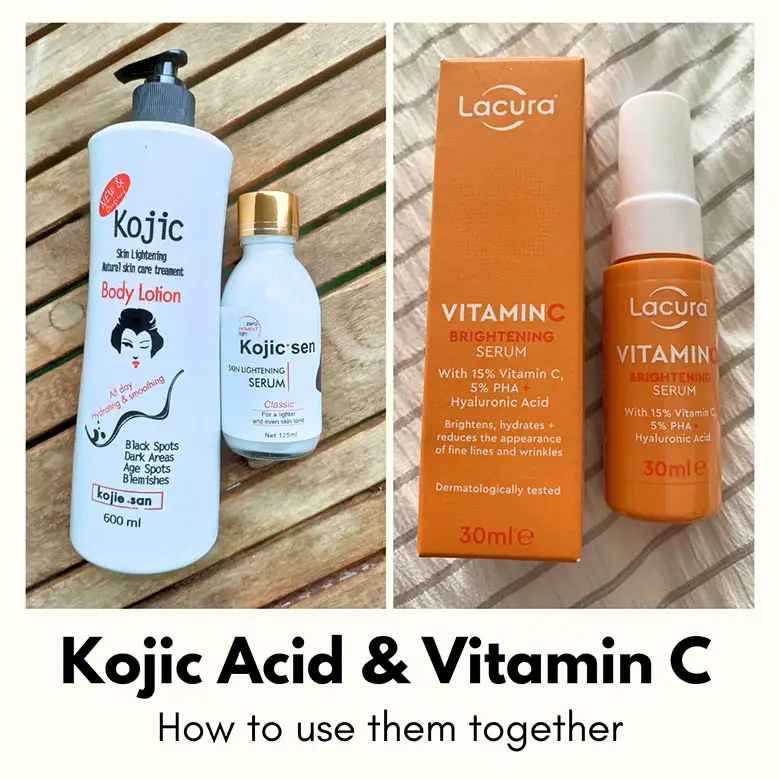
Vitamin C and Kojic Acid are two skincare powerhouses. Vitamin C brightens your skin and fights aging, while Kojic Acid fades dark spots and evens out your skin tone.
So, can you use Vitamin C and Kojic Acid together? Absolutely! When these two are combined, they work even better, giving you a radiant, healthy complexion. Together, they boost skin brightening and antioxidant effects. Vitamin C helps further reduce dark spots and also promotes collagen production.
Let’s now learn more about these two ingredients, their benefits, and how to use them safely together.
Table of Contents
- Getting to Know Kojic Acid
- Vitamin C: A Skincare Superstar
- Using Them Together Safely
- Potential Side Effects To Be Aware Of
- Conclusion
Getting to Know Kojic Acid
Kojic Acid comes from several types of fungi and is a byproduct of fermenting foods like rice wine, soy sauce, and Japanese sake. Even though it’s relatively new to skincare, it’s already known for its skin-brightening and antioxidant properties.
How It Works
Kojic Acid helps lighten the skin by inhibiting the enzyme tyrosinase, which is responsible for the production of melanin, the pigment that gives your skin its color. Too much melanin can cause dark spots and uneven skin tone, a condition known as hyperpigmentation. By reducing melanin production, Kojic Acid can help to even out skin tone and reduce dark spots.
Research, such as a 1999 study, highlighted Kojic Acid’s effectiveness in lightening dark spots, especially when used with glycolic acid and hydroquinone.
More recent studies, like a 2020 study, confirm that Kojic Acid is both safe and effective for treating hyperpigmentation and melasma. Additionally, Kojic Acid acts as a UV protector, shielding your skin from harmful ultraviolet rays and further preventing dark spots.
Besides its brightening effects, Kojic Acid also offers antioxidant benefits, protecting the skin from damage by free radicals. It also has anti-fungal benefits, which can help with conditions like ringworm and athlete’s foot. It also acts as a UV protector.
Vitamin C: A Skincare Superstar
Vitamin C is a true skincare superstar with a range of impressive benefits such as:
- Antioxidant Properties: Vitamin C protects your skin from damage caused by free radicals, which are harmful molecules from the environment like pollution and UV rays.
- Boosts Collagen Production: It stimulates collagen synthesis, which helps keep your skin firm and reduces the appearance of fine lines and wrinkles.
- Reduces Dark Spots: Vitamin C helps lighten hyperpigmentation and even out skin tone by inhibiting the enzyme that produces melanin.
How It Works
Vitamin C works by neutralizing free radicals that damage the skin’s cells and contribute to aging. Its antioxidant properties combat oxidative stress, which is caused by these free radicals. Additionally, Vitamin C supports the skin’s natural regeneration process, helping to repair damaged skin cells.
When it comes to collagen, Vitamin C is essential for its production. Collagen is a protein that provides structure to your skin, keeping it firm and plump. By boosting collagen levels, Vitamin C helps to smooth out wrinkles and improve skin texture.
In terms of brightening the skin, Vitamin C interferes with the enzyme tyrosinase, which is necessary for melanin production. By inhibiting this enzyme, Vitamin C helps to reduce dark spots and hyperpigmentation, leading to a more even skin tone.
Using Them Together Safely
Combining Vitamin C and Kojic Acid in your skincare routine can enhance their benefits, giving you brighter and healthier skin. Some skincare products already combine these two ingredients. For instance, the Superfood 2-in-1 Face & Eye Serum from PHB Ethical Beauty contains both Vitamin C and Kojic Acid and is designed to brighten and firm the skin.
It’s also good to know that a study found that a cream with 3% Kojic Acid and 2% Vitamin C effectively improved skin discolorations compared to other treatments. This shows that using products containing both ingredients is safe and effective for most people and you can even mix them together. However, if you have sensitive skin, a more cautious approach is needed.
Application Tips
For those with normal skin, using products that contain both Vitamin C and Kojic Acid should be perfectly fine. However, if you have sensitive skin, here are some best practices:
- Patch Test: Before using any new product, especially one with active ingredients, do a patch test to see how your skin reacts.
- Layering and Timing: Start by applying these ingredients separately. Use Kojic Acid in the morning after cleansing and before moisturizing, and apply Vitamin C in the evening before your moisturizer. This helps your skin get used to each ingredient without being overwhelmed.
- Low Concentrations: Begin with lower concentrations to minimize the risk of irritation. Gradually increase the concentration as your skin builds tolerance.
- Sunscreen: Always follow up with sunscreen in the morning when using these active ingredients to protect your skin from UV damage.
Potential Side Effects To Be Aware Of
When using powerful skincare ingredients like Vitamin C and Kojic Acid, it’s important to be aware of potential side effects and take necessary precautions.
Kojic Acid
- Allergic Reactions: Kojic Acid can cause allergic reactions in some people, leading to redness, irritation, or itching.
- Sun Sensitivity: It can make your skin more sensitive to the sun, increasing the risk of sunburn. Always use sunscreen when using products containing Kojic Acid.
Vitamin C
- Skin Irritation: Vitamin C can irritate sensitive skin, causing redness or a stinging sensation.
- Instability Issues: Vitamin C is unstable and can degrade when exposed to air, light, or heat. Use products in airtight, opaque containers to maintain their effectiveness.
Conclusion
Combining Vitamin C and Kojic Acid can transform your skincare routine, giving you a brighter, more even complexion. Start slow, especially if you have sensitive skin, and always patch test new products. Look for quality products that combine these ingredients, like the Superfood 2-in-1 Face & Eye Serum. And don’t forget your sunscreen—it’s essential when using these active ingredients. With the right approach, you can safely enjoy the benefits of this powerful skincare duo and achieve healthy, radiant skin. Happy glowing!
Related content:
The Benefits of Kojic Acid for Dark Lips

Petra Nakashian (previously Kravos) is a dedicated natural health and beauty blogger, driven by the loss of her parents to cancer, which led her to meticulously research beauty product ingredients. With over 10 years of experience, her in-depth knowledge has made her a trusted expert in the field. Founder of Be Healthy Now and Green Beauty Talk, Petra recently expanded her expertise with Beauty Insights Hub, exploring a wider range of beauty treatments. Committed to transparency and honesty, her work is a vital resource for navigating the complex world of beauty.

